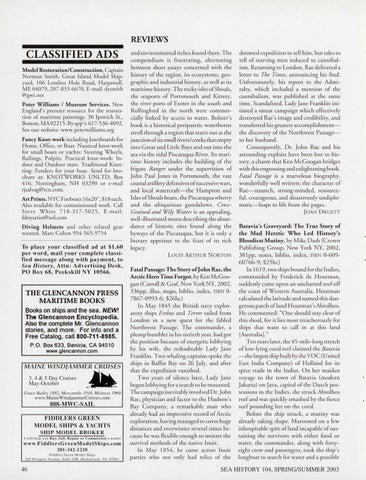REVIEWS
CLASSIFIED ADS Model Restoration/Construction, Captain Norman Smith, Great Island Model Shipyard, 106 Lombos Hole Road, Harpswell, ME 04079, 207-833-6670, E-mail: dysmith @gwi.net Peter Williams I Museum Services. New England's premi er reso urce for the restoration of maritime paintings. 30 Ipswich St., Boston,MA02215. By app't: 617-536-4092. See our website: www.peterwilliams.org Fancy Knot-work including knotboards for Home, Office, or Boat. Nautical knot-work for small boats or yachts: Steering Wheels, Railings, Pulpits. Practical knot-work: Indoor and Outdoor mats. Traditional Knotting: Fenders for your boat. Send for brochure at: KNOTWORKS UNLTD, Box 416, Nottingham, NH 03290 or e-mail rjsalvag@rcn.com. Art Prints. NYC Fireboats 16x20", $18 each. Also available for commissioned work. Call Steve White 718-317-5025, E-mail: fdnyartist@aol.com Diving Helmets and other related gear wanted. Marc Cohen 954-565-9754
To place your classified ad at $1.60 per word, mail your complete classified message along with payment, to Sea History, Attn: Advertising Desk, PO Box 68, Peekskill NY 10566.
THE GLENCANNON PRESS MARITIME BOOKS Books on ships and the sea. NEW!
The Glencannon Encyclopedia. Also the complete Mr. Glencannon stories, and more. For info and a Free Catalog, call 800-711-8985. P.O. Box 633, Benicia, CA 94510 www.glencannon.com
MAINE WINDJAMMER CRUISES 3, 4 & 5 Day Cru ises May-October
-•
Grace Bailey 1882, Mercantile 1916, Mistress 1960
www.MaineWindjammerCruises.com
888-MWC-SAIL
FIDDLERS GREEN MODEL SHIPS & YACHTS SHIP MODEL BROKER I wi ll he lp you Buy, Se ll , Repair or Co mmi ss ion a mod e l
www.Fidd le rsG ree nModel Ships.com 201-342-1220 F iddlers G reen Mod e l S hip s 24 5 Pros ec t Av enu e, Sui1e 198 , Hackensack , NJ 07601
46
and environmental riches found there. The compendium is frustrating, alternating between short essays concerned with the history of the region, its ecosystems, geographic and industrial history, as well as its maritime history. The rocky isles of Shoals, the seaports of Portsmouth and Kittery, the river ports of Exeter in the south and Rollingford in the north were commercial ly linked by access to water. Bolster's book is a historical peripatetic waterborne stroll through a region that starts our as the junction ofsix small rivers/ creeks that empty into Great and Little Bays and out into the sea via the tidal Piscataqua River. Its maritime history includes the building of the frigate Ranger under the supervision of John Paul Jones in Portsmouth, the vast coastal artillery defensives ofsuccessive wars, and local watercraft-the Hampton and Isles of Shoals boats, the Piscataqua wherry and the ubiquitous gundalows. CrossGrained and Wily Waters is an appealing, well-illustrated menu describing the abundance of historic sires found along the byways of the Piscataqua, bur it is only a literary appetizer to the feast of its rich legacy. Lours ARTHUR NORTON Fatal Passage: The Story of] ohn Rae, the Arctic Hero Time Forgot, by Ken McGoogan (Carroll & Graf, New York NY, 2002, 336pp, illus, maps, biblio, index, ISBN 07867-0993-6; $26hc) In May 1845 the British navy exploratory ships Erebus and Terror sailed from London in a new quest for the fab led Northwest Passage. The commander, a plump bumbler in his sixtieth year, had got the position because of energetic lobbying by his wife, the redoubtable Lady Jane Franklin. Two whaling captains spoke the ships in Baffin Bay on 26 July, and after that the expedition vanished. Two years of silence later, Lady Jane began lobbying for a search to be mounted. The campaign inevitably involved Dr. John Rae, physician and factor to the Hudson 's Bay Company, a remarkable man who already had an impressive record of Arctic exploration, having managed to cover huge distances and overwinter several rimes because he was flexible enough to imitate the survival methods of the native Inuit. In May 1854, he came across Inuit parties who not only had relics of the
doomed expedi rion to sell him, but tales to tell of starving men reduced to cannibalism . Returning to London, Rae delivered a letter to The Times, announcing his find. Unfortunately, his report to the Admiralty, which included a mention of the cannibalism, was published at the same time. Scandalized, Lady Jane Franklin initiated a smear campaign which effectively destroyed Rae's image and credibiliry, and transferred his greatest accomplishmentthe discovery of the Northwest Passageto her husband. Consequently, Dr. John Rae and his astounding exploits have been lost to history, a chasm that Ken McGoogan bridges with this engrossing and enlightening book. Fatal Passage is a marvelous biography, wonderfully well written; the character of Rae-staunch, strong-minded, resourceful, courageous, and disastrously undiplomatic-leaps to life from the pages. JOAN DRUETT Batavia's Graveyard: The True Story of the Mad Heretic Who Led History's Bloodiest Mutiny, by Mike Dash (Crown Publishing Group, New York NY, 2002, 381 pp, notes, biblio, index, ISBN 0-60960766-9; $25hc) In 1619, two ships bound forrhe Indies, commanded by Frederick de Houtman, suddenly came upon an uncharted reef off the coast of Western Australia. Houtman calculated the latitude and named this dangerous patch of land Houtman' sAbrolhos. He commented: "One should stay clear of this shoal, for it lies most treacherously for ships that want to call in at this land [Australia]. " Ten years later, the45-mile-long stretch oflow-lying coral reef claimed the Batavia -the largest ship built by the VOC (United East India Company) of Holland for its spice trade in the Indies. On her maiden voyage to the town of Batavia (modern Jakarta) on Java, capital of the Durch possess ions in the Indies, she struck Abrolhos reef and was quickly smashed by the fierce surf pounding her on the coral. Before the ship struck, a mutiny was already raking shape. Marooned on a few inhospitable spits ofland incapable of sustaining the survivors with either food or water, the commander, along with fortyeighr crew and passengers, took the ship's longboat to search for water and a possible
SEA HISTORY 104, SPRING/SUMMER 2003
